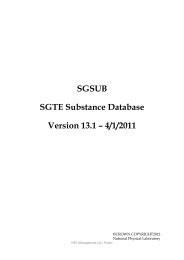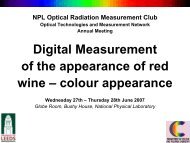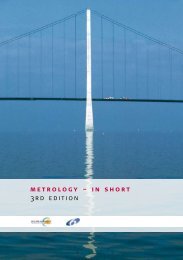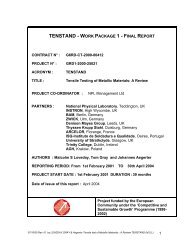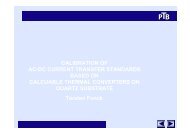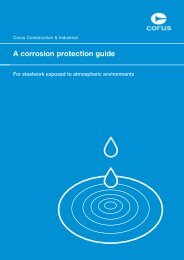EA-10/16 - National Physical Laboratory
EA-10/16 - National Physical Laboratory
EA-10/16 - National Physical Laboratory
Create successful ePaper yourself
Turn your PDF publications into a flip-book with our unique Google optimized e-Paper software.
<strong>EA</strong>-<strong>10</strong>/<strong>16</strong> • <strong>EA</strong> Guidelines on the Estimation of Uncertainty in Hardness Measurements<br />
c<br />
i<br />
∆H<br />
≈<br />
∆x<br />
i<br />
X 1 = x1 ,..., X n = x n<br />
(2)<br />
The experimental evaluation of the sensitivity coefficients is usually<br />
time consuming, therefore usually it is advantageous to use the<br />
experimental results given in literature [4, 5] and adopted for the<br />
examples attached, but one shall be careful when the relevant<br />
factors depend on the characteristics of the material tested (dwell<br />
time and indentation velocity). In this case some experiments with<br />
the specific material are necessary.<br />
u i (H) is the contribution to the standard uncertainty associated with the<br />
hardness H resulting from the standard uncertainty u(x i ) associated<br />
with the input estimate x i :<br />
u<br />
u i (H) = c i u(x i ) (3)<br />
d) For uncorrelated input quantities the square of the standard<br />
uncertainty u(H) associated with the measured hardness H is given<br />
by:<br />
2<br />
n<br />
∑<br />
2<br />
( H ) = u i<br />
( H )<br />
(4)<br />
i=<br />
1<br />
e) Calculate for each input quantity X i the contribution u i (H) to the<br />
uncertainty associated with the hardness H resulting from the input<br />
estimate x i according to Eqs. (2) and (3) and sum their squares as<br />
described in Eq. (4) to obtain the square of the standard uncertainty<br />
u(H) of the hardness H.<br />
f) Calculate the expanded uncertainty U by multiplying the standard<br />
uncertainty u(H) associated with the hardness H by a coverage<br />
factor k=2:<br />
U = ku(H) (5)<br />
Should the effective degrees of freedom ν eff in exceptional cases be<br />
less than 15, then calculate the coverage factor k according to<br />
<strong>EA</strong>/4-02, Annex E [1].<br />
g) Report the result of the measurement as follows: in calibration<br />
certificates, the complete result of the measurement comprising the<br />
estimate H of the measurand and the associated expanded<br />
uncertainty U shall be given in the form (H±U). To this an<br />
explanatory note must be added which in the general case should<br />
have the following content:<br />
The reported expanded uncertainty of measurement has been<br />
obtained by multiplying the combined standard uncertainty by the<br />
coverage factor k=2 that, for a normal distribution, corresponds to a<br />
confidence level p of approximately 95%. The combined standard<br />
uncertainty of measurement has been determined in accordance<br />
with <strong>EA</strong>/4-02 [1].<br />
July 05 rev.00 Page 12 of 24



